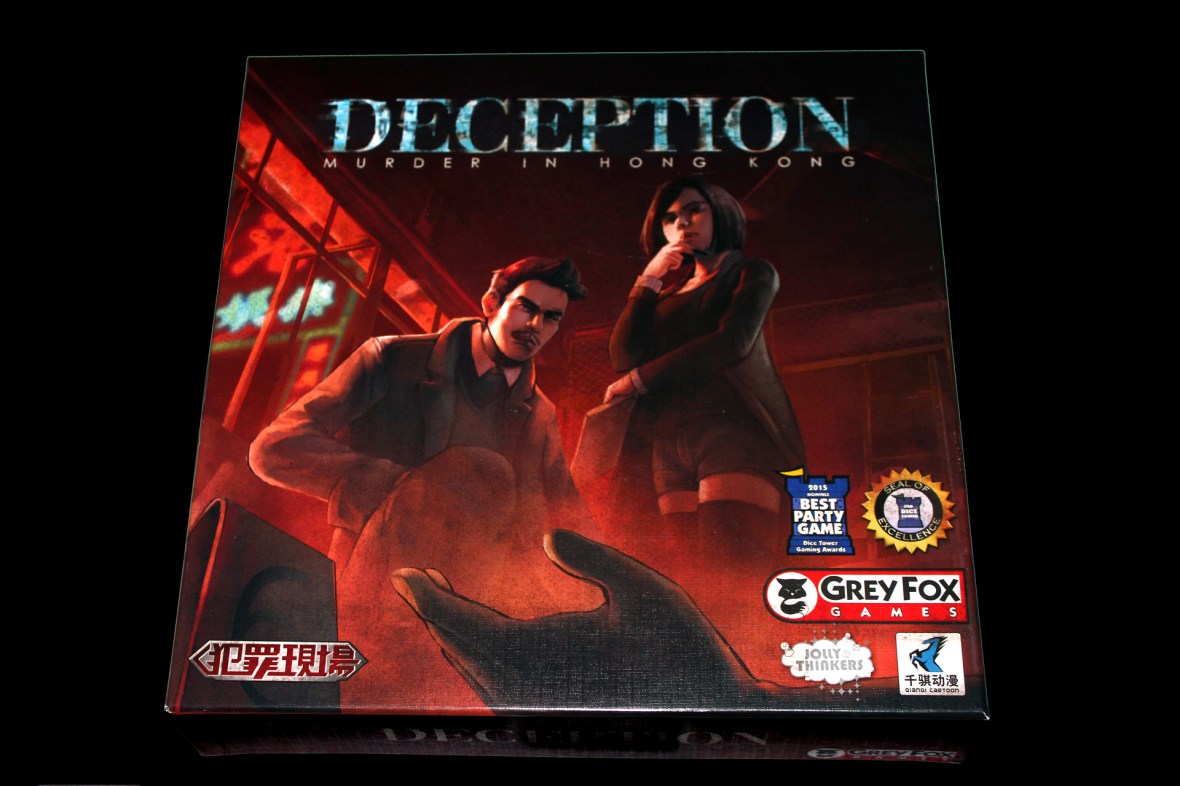
Base price: $40.
4-12 players.
Play time: ~30 minutes; you should probably use a timer.
BGG Link
Buy on Amazon (via What’s Eric Playing?)
Again, yes, timely reviews of games with Kickstarter expansions currently up, I know. But, hey, it seems like as good a time as any, considering Saloon Tycoon and Roll Player both got theirs funded. Plus, Deception: Undercover Allies is also funded, and it comes with a bigger box for the KS backers to put both games in. That’s always nice.
Someone’s dead in Hong Kong. Murdered, by the sounds of it. At least, that’s the name of the game. In Deception: Murder in Hong Kong, you and your friends play as Investigators trying to solve the murder of … someone, I guess. However, be careful! One of your Investigators is the murderer, trying to get away with their crimes. Will you be able to figure out who the murder is? Or will you put your badge on the line to no avail?
Contents
Setup
Setup for this game is (as I’ve been saying a lot) fairly simple. First, there are 12 Role Cards and 11 Badge Tokens:
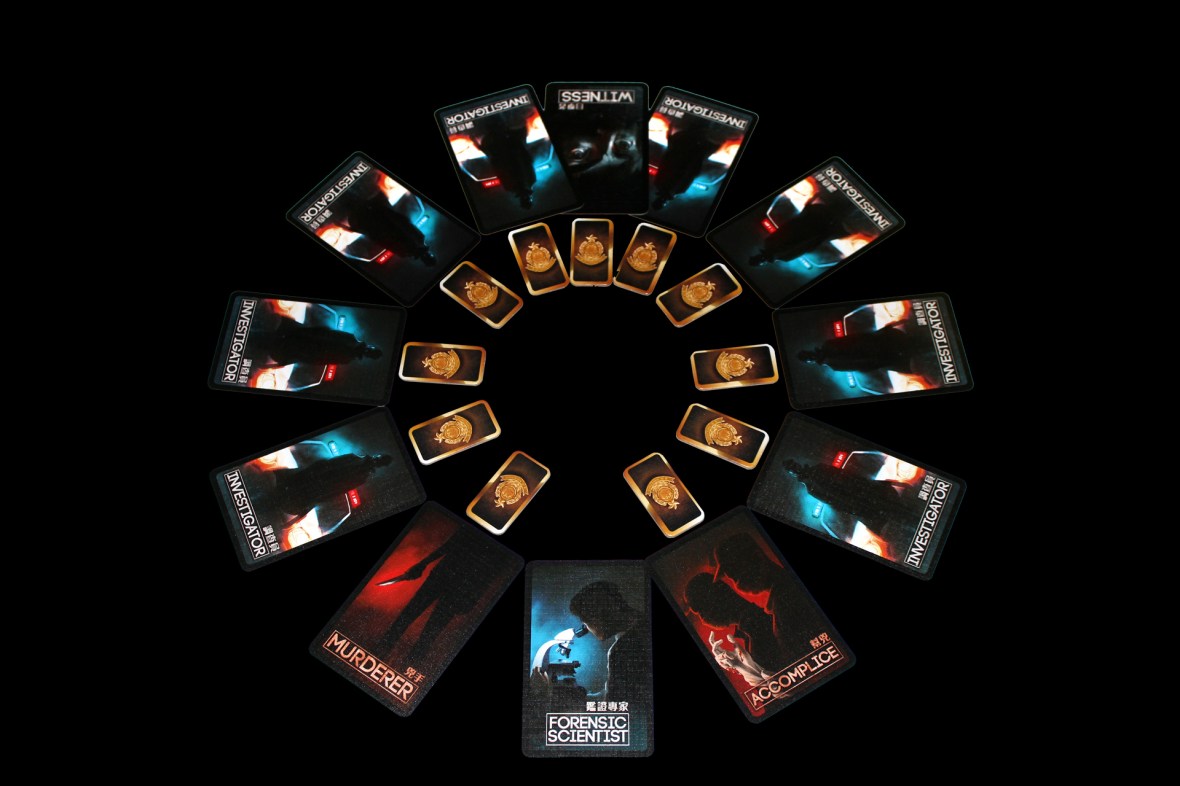
You will need at least the Forensic Scientist, the Murderer, and the Investigators. For everyone’s sanity, give the Forensic Scientist to the player that understands the rules the best or the most experienced player, a la Mysterium (this comparison is going to happen a lot). Shuffle the other roles and deal them out at random, along with giving each other player a Badge Token. If you want to make the game harder for the Investigators, add in the Accomplice. If you want to make the game a bit closer to The Resistance: Avalon, add in the Witness. I’ll explain what they do later.
Next, there are several blue Means cards:
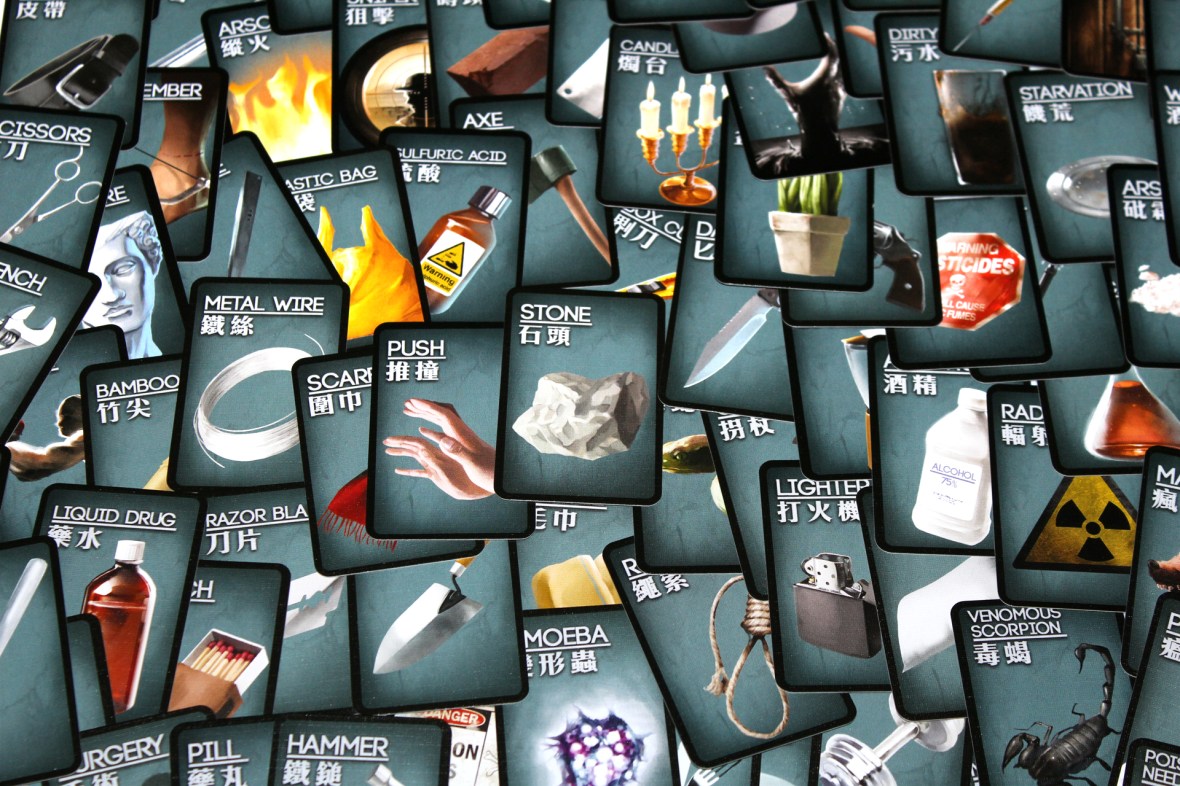
These are essentially the murder weapons (or ways to murder someone, if you’re looking for creative inspiration, I guess?). There are also red Clue cards:

This isn’t even all of them.
These are clues left behind at the scene, I suppose? Either way:
- In an Easy game, give each player (except the Forensic Scientist) 3 Means cards and 3 Clue Cards.
- In a Standard game, give each player (except the Forensic Scientist) 4 Means cards and 4 Clue Cards.
- In a Hard game, give each player (except the Forensic Scientist) 5 Means cards and 5 Clue Cards.
Note that this makes the game easier or harder for the Investigators. It has the opposite effect for the Murderer.
You’ll find some Scene tiles and bullet markers, as well:
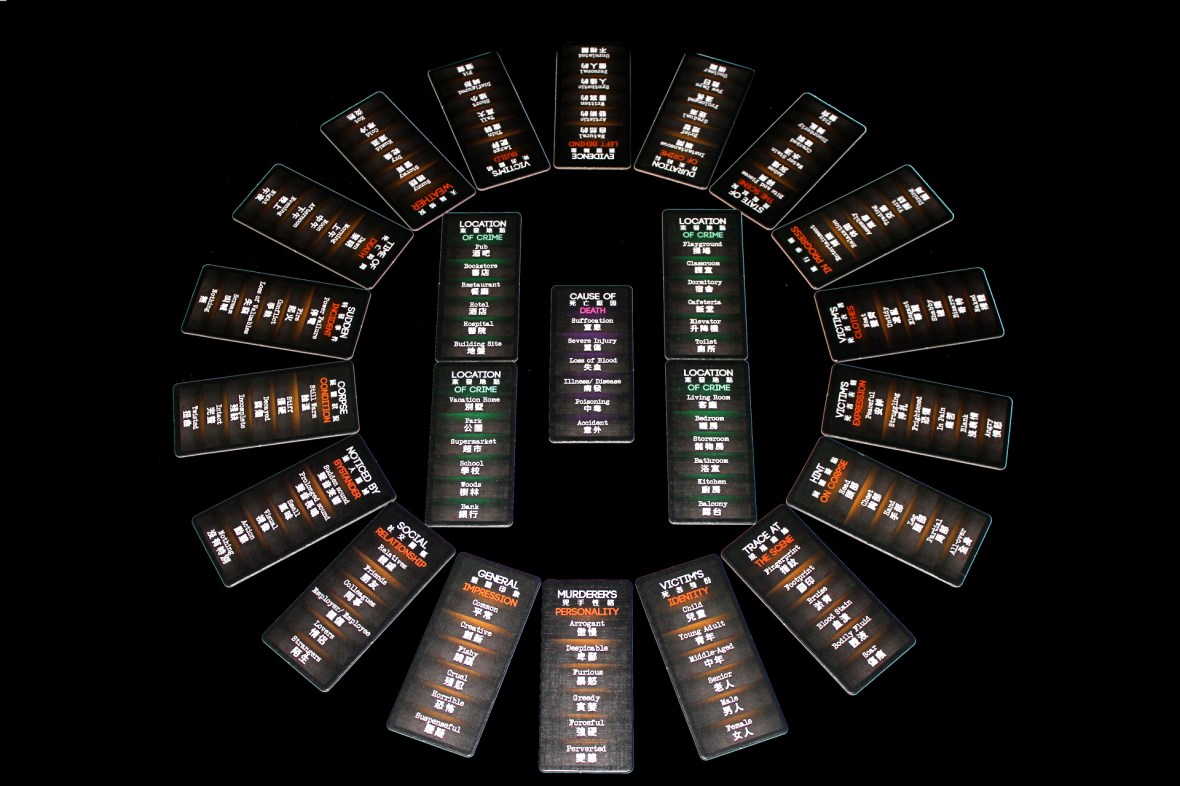
And some Event tiles:
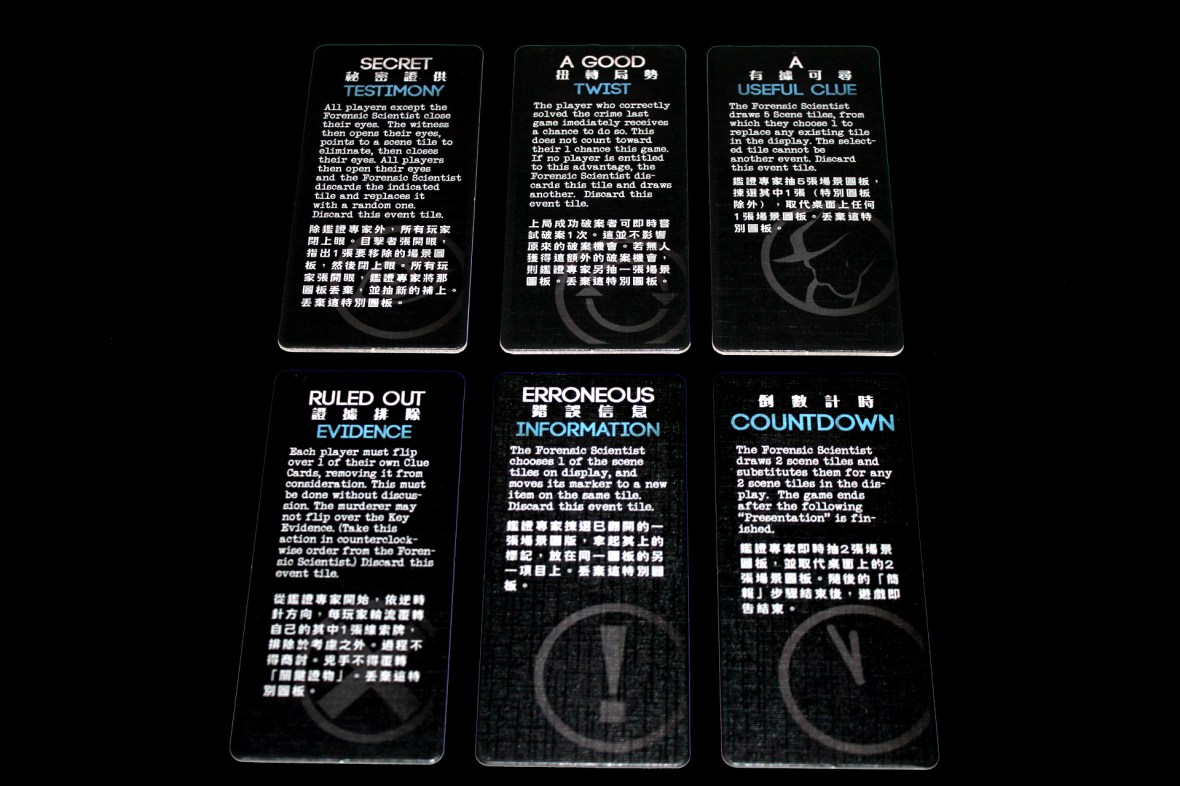
Put the Event tiles aside — they’re an optional variant, and I wouldn’t recommend them in your first game.
Once you’ve done that, shuffle the orange Scene tiles and put them in a stack, face-down, with the purple Cause of Death tile and the green Location of Crime tiles near the Forensic Scientist. They’ll need them later.
Your play area should look like this, and if it does, you’re ready to start:
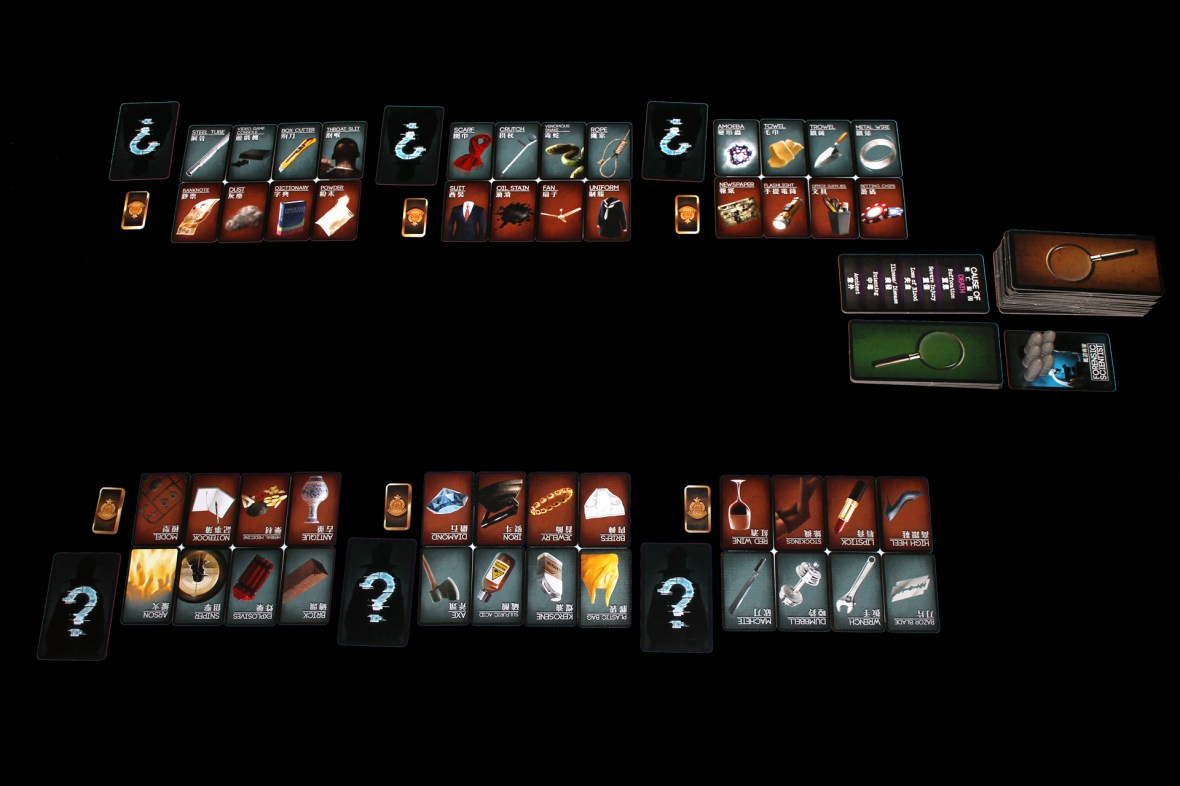
Gameplay
So, the goal of Deception: Murder in Hong Kong is for the Investigators, guided by the Forensic Scientist, to guess the correct combination of Clue and Means cards (held by the Murderer) to solve the crime. If that sounds like competitive Mysterium, you’re not that far off.
As with many social deception games, before the game starts, there’s a night phase, similar to Avalon, Secret Hitler, or One Night Ultimate Werewolf. It plays as follows, with the Forensic Scientist saying the quoted parts:
- “Everyone, close your eyes.” You should confirm that everyone has closed their eyes, as you might guess. Except for you.
- “Murderer (and Accomplice, if you’re using that), open your eyes.” Make sure they’ve done so.
- “Murderer, choose one of your Clue Cards and one of your Means cards.” These will become the Key Evidence and Means of Murder for the other players to guess if they want to solve the murder. Make sure you know which ones they picked. The entire game will be ruined if you forget.
- “Murderer (and Accomplice), close your eyes.”
- If you’re playing with Witness:
- “Witness, open your eyes. Murderer and Accomplice, put your thumbs up so that the Witness can see who you are.”
- “Witness, close your eyes. Murderer and Accomplice, put your thumbs down.”
- “Everyone, open your eyes.”
Definitely easier than trying to do One Night by yourself.
The game takes place over three phases of Evidence Collection. I’ll explain each in turn. Note that during the game, the Forensic Scientist may not say anything to indicate who the Murderer, Accomplice, or Clue / Means cards are. No gestures, no signals, no expressions, nothin’. You are essentially a quiet ghost.
Before you start the rounds, also, the Forensic Scientist takes the Cause of Death tile, chooses one of the four Location tiles, and draws four random Scene tiles from the shuffled deck and places them out where all players can see them. Do yourself a favor, Forensic Scientist, and read them closely, first.
- Round 1
- Evidence Collection (I usually set a timer for 8 minutes.): The Forensic Scientist takes each of the six bullet markers and puts them on a tile in front of them next to one of the six items on the tile. You can only put one bullet marker on a tile. You can also place at any speed you want, but if you set a timer, be mindful of it.The key thing, here, is that other players may freely discuss what they think you’re trying to hint via your placements. You should try to give hints / clues by where you put the bullet markers. For instance, if the Means of Murder is “Blood Release” then perhaps the Cause of Death is “Loss of Blood”? The Forensic Scientist should listen to the discussion and place accordingly to try and steer players towards the correct items.As a brief aside, all player should avoid trying to break the game with “if Johnny’s the Murderer, Forensic Scientist should say the cause of death was ‘Illness / Disease'”. It is not explicitly forbidden by the game, but it’s definitely not in the spirit of it.Once you’ve placed all six markers, move on to the next phase.
- Presentation: Each player (starting with the player on the FS’s left) now gives a 30-second-ish presentation on what they think the Key Evidence and Means of Murder might be. You CANNOT interrupt the player presenting unless you are formally “Solving the Crime” (more on that later). This should be strictly enforced, especially since it gives every player the chance to offer some insight and not get shouted over.
- Round 2:
- Evidence Collection (I usually give 3-4 minutes, here.): The Forensic Scientist draws a new Scene tile and replaces one of the orange Scene tiles already out (not Location of Crime or Cause of Death; you’re stuck with those). If you’re playing with the Event Tiles, shuffle them into the Scene Tile deck at this point. If you draw one, activate it, and then remove it and draw a Scene tile. They then place a bullet marker on one of the six items on the new tile, as they did in Round 1.
- Presentation: Again, every player has a chance to present on the new evidence. Do not interrupt other players while they are presenting. Do not talk.
- Round 3
- Evidence Collection: The same as Round 2-1’s.
- Presentation: Also the same as Round 2-2’s. However, if the crime is not solved by the time the last player to present finishes their presentation, the Murderer and the Accomplice win!
As you might guess, it’s important to figure out how to solve the crime.
If you want to attempt to solve the crime, you can slam your badge on the table to formally put your badge on the line. You name the Clue and Means cards in front of another player as the ones you think are the Key Evidence and the Means of Murder. If you are correct, the Investigators (and Forensic Scientist) win! If you are incorrect (or only partially correct), the Forensic Scienctist just says “no” and can provide no additional context or information. If you fail to solve the crime correctly, you can no longer attempt to solve the crime later. You can still participate in discussion and make presentations, you just can’t solve the crime. If every player has attempted to Solve the Crime and was unsuccessful, the Murderer and Accomplice instantly win. Makes sense, really, but worth saying.
Make sure everyone has tried to solve the crime before the last player presents. If you don’t, you lose.
One last thing — if you’re playing with the Witness, the Murderer gets one chance to guess who they think the Witness is, if they’re caught. If they’re correct, they kill the Witness and get away with the crime! If not, Investigators win, still.
Player Count Differences
Honestly, I don’t notice a ton of differences at various player counts. Obviously you only want to use the Accomplice or Witness at higher player counts since there are more players, but other than that there’s not a big change to the game. I will say that the game takes longer when you have more people, but that’s only because of the 30 second presentations. I don’t have strong player count preferences, here, but I would be hesitant to play it at four or five (similar to One Night Ultimate Werewolf or Spyfall).
Strategy
There’s actually a lot to this, in my opinion.
- Generally my group thinks that the Murderer should try to pick a Means of Murder such that it can best be described with “Severe Injury” as cause of death. It’s the broadest category, so it makes it very difficult to narrow down. They’re fixing this a bit with the expansion, by adding more cards so the other categories are a bit more viable.
- Murderer, make sure you look at everyone else’s cards before you pick. You should try to pick something that’s pretty common, as that also makes it harder to disambiguate your cards from someone else’s. I got crushed in one game because the Murderer picked Kerosene, had Lighter, and another player had Arson. Very tough to distinguish between those.
- Murderer and Accomplice, try to subtly prop up other people’s suggestions, as long as they’re not suggesting you. You want to steer suspicion away from you, preferably onto someone else.
- Murderer, I find that it helps to pick two cards that aren’t really associated with each other. This makes it harder for the Forensic Scientist to build a cohesive narrative, so it’s harder for the Investigators to figure out what the pair of Clue + Means cards are.
- Investigators, remember that the Clue + Means cards don’t necessarily need to be associated with each other. The Murderer may try to pick disjoint sets so that it’s harder to build a cohesive narrative (like I just said), and the Forensic Scientist may be hinting towards a Clue or (technically xor) a Means, rather than both at the same time. Be mindful of that, if you can.
- Investigators, pay attention to the order and time that the Forensic Scientist places on cards. If they’re placing later, it might mean that they’re less confident in that assessment (or that they misread the card, which is dangerous and unfortunate). Watch for things like hesitation or indecision to try and glean subtle clues, if you can.
- Investigators, pay attention to which cards the Forensic Scientist removes. It might be that they remove a hint to something that everyone agrees on already (“It must be something to do with fire!”) in favor of narrowing down the other part of the pair. It might be that you’re getting off-track based off of that hint, so the FS wants to pull it out so it stops confusing you. It might have been a bad hint. Just worth thinking about.
- Investigators, remember that you’re on the same team. You all win if any of you wins, so make sure you’re not talking over other people or letting one person control the entire conversation. All theories and ideas should be tolerated, even if they’re ridiculous. You’re trying to solve a murder, after all. Also, don’t talk while other people are presenting. Sometimes, to help the team, you may need to throw in your badge and make a guess. Other times you might want to force a suspicious person to make a guess to prove they’re not the Murderer or Accomplice.
- Forensic Scientist, pick your Location of Crime tile carefully. You get to choose out of the four, so try to pick the best one and think through it carefully.
- Forensic Scientist, remember your audience. Try not to shoot for obscure understandings of things or mental leaps, since you win if the Investigators win. That said, you should try to build a narrative (and maybe tell the story of the crime after the game ends? I think that’s always fun).
Pros, Mehs, and Cons
Pros
- Great game for groups. Like Mysterium, it’s one where a lot of people get to talk, but it’ll still appeal to the social deception crowd, since there’s some element of intrigue among the group. Plus, it plays pretty well at high player counts, which is not true for many games.
- The art / theme are pretty cool. I like the whole aesthetic. It’s very urban, city nightlife, etc. Not much to say past that.
- It’s pretty fun to be every role. I don’t think there’s a single role that isn’t interesting or fun to be, which is also impressive for a social deduction game. One Night Ultimate Werewolf can get there with some expansions + tweaking, but this’ll work straight out of the box.
- Highly variable games. It depends so much on what cards are drawn, who gets what role, what cards they choose, what tiles the Forensic Scientist draws, what choices they make, and who can steer (or derail) the conversation. It’s very cool!
- The presentation phase is a fantastic idea. I like that it lets every player make a specific, personal inclusion. My only issue with it is that I wish it started with a random player and then went in a circle, rather than always starting with the same person. I don’t think it’s bad from a gameplay perspective, it just stresses the person on the left of the Forensic Scientist out, in the games I’ve played. I might move it around a bit in the future, just to try it.
- Seems like it has room to grow. I could see expansions, new Event and Scene tiles, maybe even more roles coming in for future games and I’d be really open to where that takes the game. Even more Clue / Means cards could be really cool! I’d love to try them out.
Mehs
- Some players can get somewhat left out if other players are loud enough. This is a game where (like many social deduction games) some other players may feel like the “most correct” person is the loudest. This can cause issues, since you’re ostensibly on a team together. Even as the Forensic Scientist, you might want to offer some way to make sure everyone’s voice is included in more than just the presentations, though I do still think that’s an excellent mechanic to try and make sure everyone gets included. So much so, in fact, that this ends up as a “Meh” rather than a “Con”.
- Only being able to guess once seems a bit small on a “per person” level. At a macro view, it makes sense, but it’s kind of a bummer to guess incorrectly and be incapable of figuring out who the murderer is. Not sure if there’s much to be done about it, just something I’ve got mixed feelings about.
Cons
- Any serious mistake as a Forensic Scientist can really cost you the game. I think it’d be reasonable to allow the Forensic Scientist some ability to correct or change placed bullet tokens later in the game (balanced out, of course) to prevent new players or new Forensic Scientists from getting wrecked, but it’s tough.
- Some of the orange Scene tiles are useless. I’ve never seen Weather help the team, and I imagine that’s slightly by design, but it can feel very frustrating if they’re off course and you need to steer them back on to draw something near-completely useless.
- Needs a timer, in my opinion. I find the game can run a bit long, and that makes it a lot easier for the Investigators since they can explore every logical avenue and just talk and talk and talk until they’ve started to figure out who is untrustworthy. It’s like if you played One Night Ultimate Werewolf with no timer — eventually someone would figure it out. I think a timer keeps it interesting, but the Forensic Scientist should be flexible and not cut anyone off. We’ve been playing a lot more with a timer and it’s been really good.
Overall: 7.75 / 10
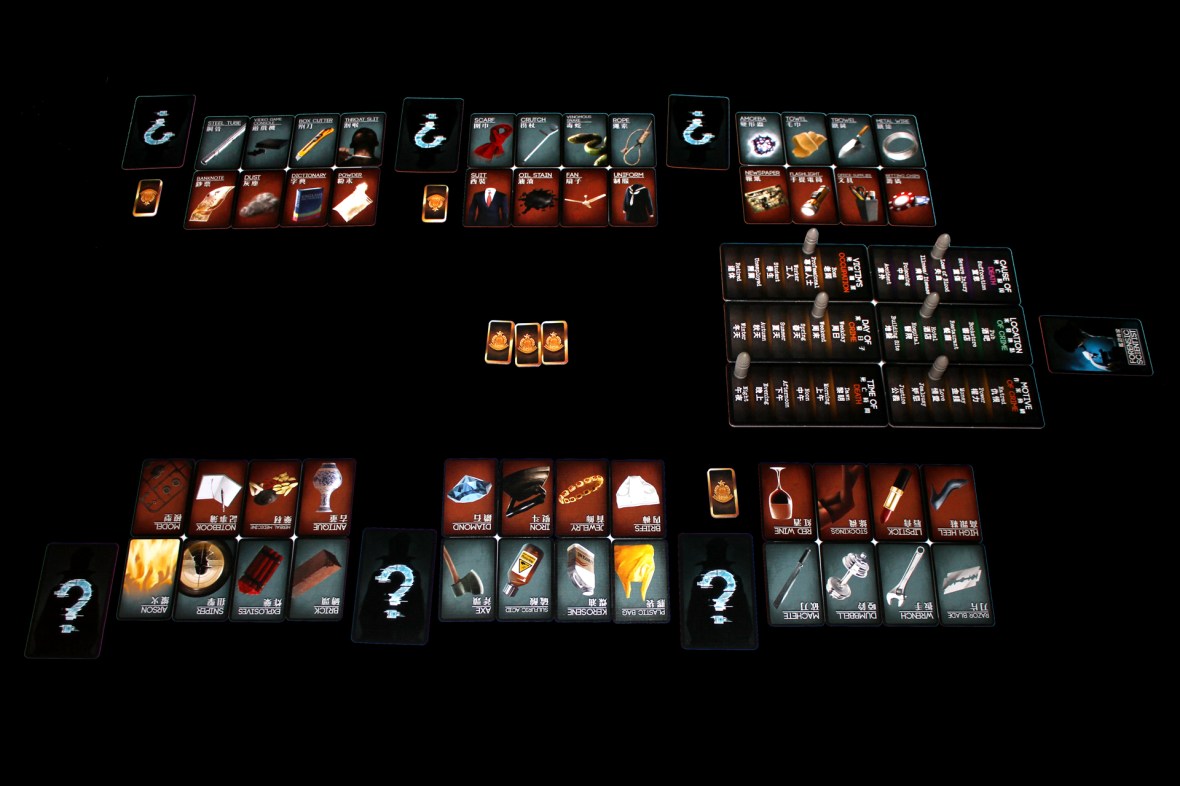
Overall, I think Deception: Murder in Hong Kong is a solid game! I think if you pushed me on it, I’d say that I prefer Mysterium for a few mechanical reasons (I think players can make more contributions and the feedback cycle is more rapid, so you don’t make as many costly mistakes, for instance), but I think it shines in its own ways (gives every player a chance to speak, higher player count limit, shorter game, an ending that makes sense to me). For me, it comes down to preferring cooperative games over competitive games, but hey, if you like one, you’ll probably still like the other (unless you hate competitive or cooperative games, as some do, and in that case I’d say maybe not???). Either way, I still think Deception: Murder in Hong Kong is a lot of fun, and I’d recommend checking it (and the expansion, which I’ve already backed) out!